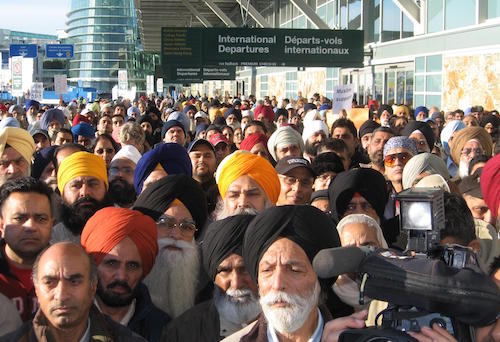Writing at the Verso blog, George Ciccariello-Maher, a professor of politics at Drexel University in Philadelphia, outlines a direct-action strategy for resisting the deportations promised by Donald Trump. Crucially, Ciccariello-Maher teases out the fundamental connection between deportations and the prison industrial complex in the US, as well as the links between anti-immigrant sentiment and anti-black racism and Islamophobia. Here’s an excerpt from this urgent piece:
But one question will be strategically central for resisting a Trump presidency: migration. While Trump softened his rhetoric on many issues immediately after the election, he doubled-down on plans to immediately deport or incarcerate millions of migrants. There is every reason to take this threat seriously, and many of the more than half a million who have registered for Deferred Action (DACA) are rightly worried not only that Trump will immediately scrap the program, but that he might use their registration information to speed deportation. While many upset by Trump’s election are already pledging to reinforce and expand sanctuary city programs, these appeals must be supplemented by a strategy of mass action to obstruct deportations and to make Trump’s ambitious plans literally impossible to carry out.
Luckily, this strategy won’t have to start from zero, but will instead build on spontaneous and organized efforts by communities nationwide. For years, organizers across the U.S. southwest and beyond have been deepening resistance networks in undocumented communities, beginning with an everyday culture of resistance and disobedience: neighbors warn neighbors when they see Immigration and Customs Enforcement (ICE) operating in the neighborhood, even some with papers refuse to show them, and it’s not uncommon to see someone on the side of the road with an improvised sign warning of checkpoints up ahead. Other, more organized efforts have seen the establishment of nascent rapid-response networks that have actively sought to obstruct ICE by warning residents and even blockading homes to prevent deportation raids from being carried out…
Direct action against deportation works, both tactically — to hinder ICE’s functioning while concretely protecting some from the hell of deportation — but also politically, as a tool for mass mobilizing and to provoke a national debate over the freedom of movement. Moving forward, organizations with deep roots in local communities will prove crucial relay points for a broader anti-deportation strategy, building the necessary infrastructure locally while networking nationally and shepherding volunteers and organizers into mass, mobile flying squads capable of obstructing ICE’s work by warning communities and physically preventing raids from being carried out.
While migration will be strategically central to resisting Trump’s white supremacist agenda, however, it is in no way separable from the anti-Blackness and Islamophobia on which Trump’s popularity rests. In fact, one strength of direct action lay in the barriers it helps to break down and the new collective identities it helps to forge, enacting powerful new solidarities that defend the most vulnerable and put into practice the motto that an injury to one is an injury to all. Within migrant communities, this means for example defending DACA while at the same time refusing the arbitrary division it introduces into migrant communities, between those deserving and undeserving of deferred status — and it means fighting all deportations, regardless of status or criminal record.
Image: Protesters blockade Vancouver International Airport to prevent deportation of Lalibar Singh, December 2007. Via Verso blog.
